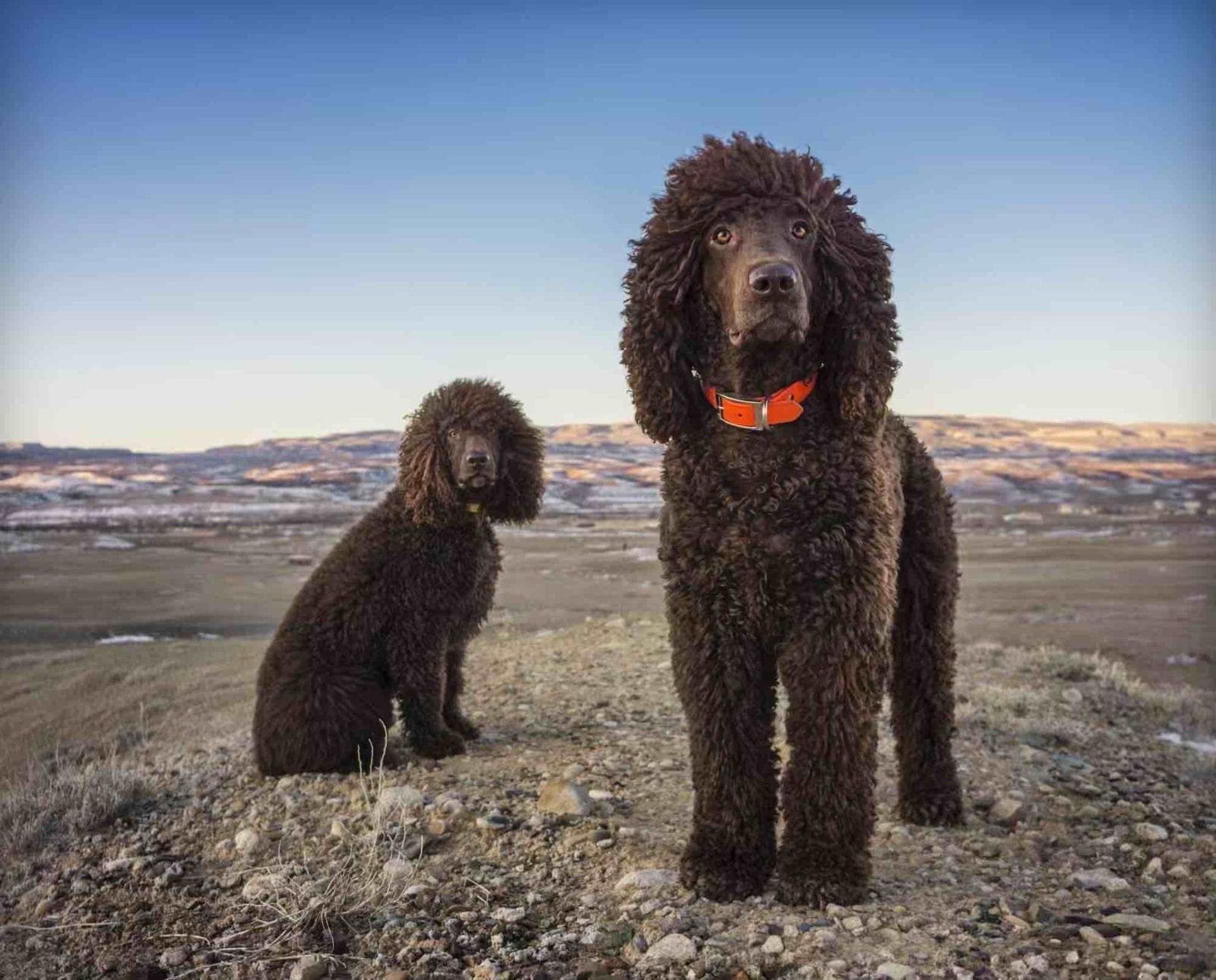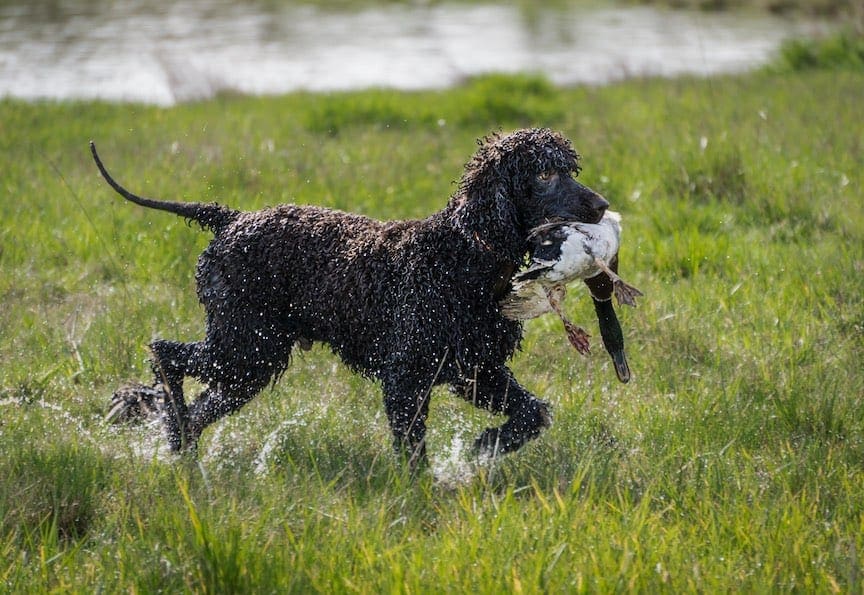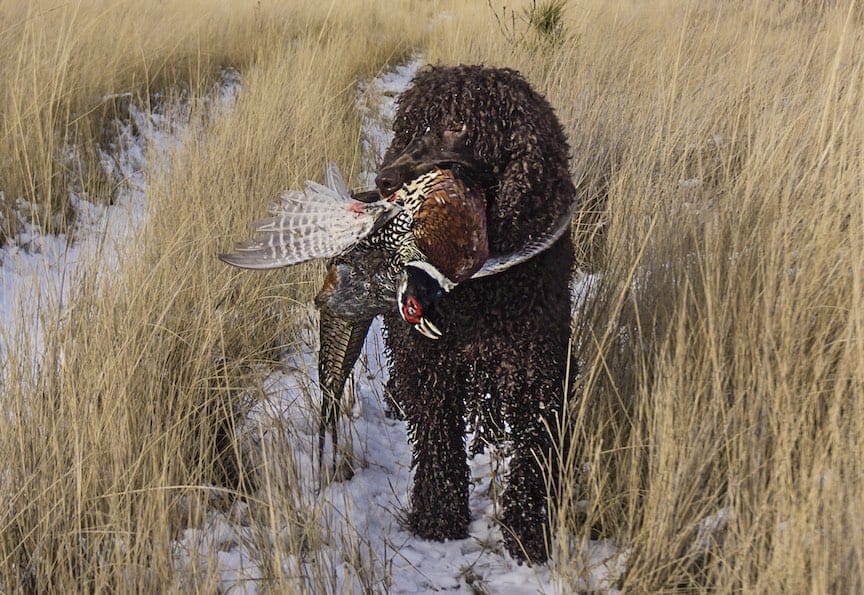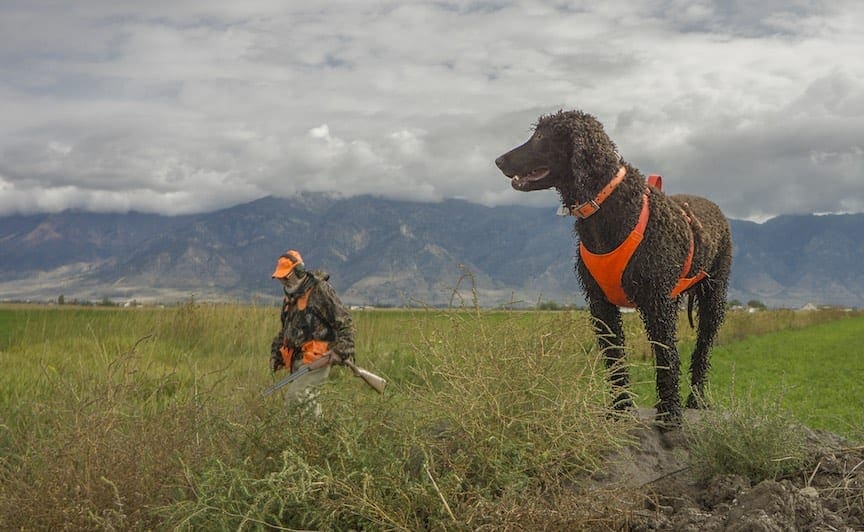Home » Hunting Dogs » Irish Water Spaniel: A Versatile Dog Breed Indeed
Irish Water Spaniel: A Versatile Dog Breed Indeed

Southern Idaho is where Russell Dodd and his Irish Water…
Discover the history, personality, hunting style, and training requirements of the unique Irish Water Spaniel
Is that a Doodle?
…No, it is an Irish Water Spaniel.
I thought water dogs were from Portugal?
…It is a spaniel.
Oh, a Portuguese Water Spaniel!
…No, an Irish Water Spaniel.
Are you sure it is not a Doodle? It looks like one.
…I’m sure.
This common conversation is one way that you can tell that your 65-pound, curly brown gundog is a rare breed. But the Irish Water Spaniel was once the third most popular hunting dog in the U.S. When the founders of the American Kennel Club established the AKC in 1878, this common dog was included as one of eight breeds that could be registered—all of which were gundogs.
Since then, all of the common gundogs have surpassed these large spaniels in popularity; in the case of the ubiquitous Labrador Retriever, it has been by orders of magnitude. Currently the AKC ranks the Irish Water Spaniel popularity at 170 out of a total of 193 breeds, with only the Sussex Spaniel being a more obscure gundog.
History of the Irish Water Spaniel
This now-rare breed’s history is intertwined with the development and use of the modern shotgun, so by definition it is a gundog. While the culture of the British Isles and Ireland have a much more reserved attitude about the public ownership and use of firearms, the Kennel Club of the United Kingdom is unabashed in categorizing the whole group of Pointers, Setters, Spaniels, and Retrievers as gundogs. Meanwhile, back in the U.S. with our love of guns, we are a bit more politically correct, and the AKC classifies these breeds as Sporting Dogs.
During the early 19th century in the British Isles, the art and obsession of breeding livestock was codified. That fascination with animal husbandry transferred immediately to consolidating a variety of water dogs and regional spaniels into distinct and consistent gundogs. In Dublin, Justin McCarthy’s breeding kennel was the single source for today’s Irish Water Spaniel. In the 1830s, he amalgamated the attributes of the spaniel hunting dogs and the retrieving and working water dogs of southern Ireland into a consistent, robust, and dependable all-purpose gundog. Today, all Irish Water Spaniels have a pedigree that starts with McCarthy’s stud dog, appropriately named Boatswain.
Irish Water Spaniels in the field
The attribute of covering the field in front of the hunter and yet staying within gunning range is a primary distinction of any hunting spaniel. If heavy cover is hiding and protecting an upland bird from the sportsman, a spaniel is more than happy to bust in and push out the bird. But if you also require a dog that is especially willing and competent at water retrieves, then the Irish Water Spaniel is a fantastic choice as an all-purpose gundog. Its abilities to work with a handler, stay calm in a boat or blind, and enjoy a rigorous cold-water swim are attributes lacking in many other high-energy spaniels. These characteristics were specifically sought after in developing the retriever breeds that are abundant today.

So why did this brilliant and once-popular gundog recede into obscurity while the Labrador Retriever zoomed to the number one position? Primarily the coat. The Irish Water Spaniel has a continuously growing, non-shedding coat that is nature’s Velcro. Burrs, grass awns, and twigs are easily snagged by the Irish Water Spaniel coat and will entangle and disappear quickly into a mat that only scissors and clippers can remove. For every hour in the field, there may be equal time needed for grooming. Depending on where you hunt and train, the debris entangled in the coat can either be mildly annoying or a trial worthy of Sisyphus. Heavy, wet snow can even bond to the coat like balls of concrete. While not a problem for waterfowl retrieving in the estuaries in Ireland, trekking through a snow-covered cornfield in the Midwest can often reveal this unfortunate feature of this curly-coated dog. In contrast, the Labrador Retriever is a wash-and-wear dog that can be run hard and put away wet. While the hunter with a long-coated dog is grooming out the debris, his hunting partner’s Lab is catching a nap in the crate, getting ready for tomorrow’s hunt.
When asked why I chose an Irish Water Spaniel over a Labrador Retriever, my off-the-cuff answer is that I prefer dog grooming over vacuuming. With some preventive clipping to shorten the coat of an Irish Water Spaniel before spending time in the field, the major problems can be mitigated and any entangled debris is much easier to remove. Folks that hunt with their Irishers call this a field cut.
Listen: Irish Water Spaniels with Russell Dodd – HDC Episode #23
A unique and quirky personality
If you are looking for a dog that lives to please the handler and will work their tail off just to be your best friend like a Labrador, then seriously reconsider the Irish Water Spaniel. Their personality and charm, while similarly endearing and charismatic, is not cast from the same mold. The Irish Water Spaniel is fun, quirky, and engaging. Their work ethic can be intense, but this intensity and focus is often to satisfy their own motivations, and a pleased owner/hunter is a fortunate byproduct.
The Irish Water Spaniel will often second-guess the hunter and offer additional options on what might be a better way to find birds. They are powerful observers and remember patterns in the environment and the hunter’s behaviors. If you think you’re good at knowing when your dog gets “birdy,” Irish Water Spaniels know at least as much about their hunter’s abilities. If you don’t establish the pattern that you are the team leader and hunting expert, they will make every effort to fill the vacuum. The results can be frustrating, humorous, or productive.
Because most of our canine hunting companions are actually pets for 99% of their life, the charm and humor of these canine extroverts bring a joie de vivre to everyday living that is a delight and promotes a strong breed loyalty among their human companions.
While it is convenient and concise to describe the attributes and personality traits of a specific breed in one paragraph, it can miss the element of describing the diversity of skills and traits that relate specifically to bird hunting. The phrase, “Clown of the Spaniels” is often used to describe the Irish Water Spaniel and is reasonably accurate in describing these fun-loving and creative creatures. “High energy” and “loves to work” are modern euphemisms for, “If you don’t give this dog a job and train it, you will have a devil on your hands because the dog will make its own rules.” But if you are a bird hunter, these are traits that will reveal the virtues of this breed. When an Irish Water Spaniel works autonomously, it is not with an attitude of blowing off the hunter; instead, it is showing an understanding of terrain, cover, wind, and bird behavior. An Irish Water Spaniel with enough field experience will log all the conditions into their canine database and solve the problem of where to find birds. If they have the confidence that the hunter is a competent partner, then they will team up for mutual benefits.
They are incredibly social with humans, especially their owners. They have been described as having a “strong head and soft heart,” which can make their training regimen a bit different than a biddable Lab. Their social bond with their owner can be an issue with sending an Irish Water Spaniel off to a professional trainer where the dog spends its down time in a kennel. They love working, they love training, they love hunting… but they do best when they get to work with their favorite person.
Training and hunting with an Irish Water Spaniel
While generalities about most breeds can be mostly correct, there is a spectrum in the Irish Water Spaniels as well. My 12-year-old female, Tooey, has always been a serious and low-key personality compared to my exuberant males. But her prey drive and persistence have always brought home the birds, especially the ones that elude the gunner and other dogs. One of her favorite activities is to work the fields at the end of the day after an AKC spaniel hunt test. More often than not, she will find, flush, and run down the pheasants or chukars that have eluded all the dogs and gunners from the day’s hunt test. In her own way, she has entertained us as well. At an AKC retriever hunt test in western Oregon, we were at the line and waiting for a duck to be launched, shot, and then retrieved. Upon being catapulted into the air, the live bird did not cooperate and had the misfortune to hook a hard right and fly directly at a gunner in the blind. He instinctively brought up his gun and dispatched the duck at about 15 feet with a direct hit of a 12-gauge round from a full choke. Tooey dutifully marked the fall and trotted out to make the required retrieve. Upon arriving at the scene, she stopped short and surveyed the carnage. After a brief evaluation on her part, she determined what she thought was the largest piece and picked up one of the duck-like objects. As the gallery applauded her choice and style, she brought back and delivered the remnants of a single wing to hand and earned another pass toward her Junior Hunter title.
This versatile breed not only has the attributes of a close-working dog, quartering autonomously in front of a hunter, but also is quite capable of following verbal and hand signals from the hunter in directing the dog to the area where the bird went down. It is this attribute, favored by retriever loyalists, that is a core element that was bred into the Irish Water Spaniel from the beginning. Where the typical spaniel will excel at being canine mine sweepers pushing up birds, the Irish Water Spaniel adds additional skills of being an excellent partner, acknowledging and following hand and verbal signals to locate downed game.

The semi-arid western United States, where I hunt, is about as far from the bogs and estuaries of Ireland as one can find. But for a high-drive gundog, a bird is a bird. On one winter hunt, my Minnesota-bred Irish Water Spaniel, Cooper, knew little of his Celtic origins as we slogged our way through a foot of snow and sagebrush in central Oregon. Cooper was out in front, checking out cover where pheasants were likely to hole up (ringneck pheasants were introduced into North America not too far from here in 1881). It was in this distinct desert cover where Cooper pushed a rooster out from the backside of a dense cluster of sagebrush. The bird took off fast and low, just clearing the tops of this high desert cover on its way to the next county. Patrice, my wife, took a swinging shot with her 20-gauge. The bird twitched as feathers scattered, but it locked its wings and glided across a rocky ravine and disappeared into the brush and snow about 100 yards away. Because of the tall cover, Cooper’s view was blocked and he never saw the bird flush or where it landed.
He had heard the gunshot, though, so he knew that something was worth his attention and he stepped out to locate the position of Patrice’s shotgun report. Patrice blew a single whistle chirp to get his attention. He sat; she took a step to her right with an arm out to her side and called, “Over.” Cooper took off, bounded down into the ravine and up over the snow-covered rocks to the other side. Responding to another short whistle blast, he spun and looked back at Patrice. She gave another hand signal to cast him back, and he was off in the direction where we had seen the bird land in heavy cover. At the spot where the bird disappeared, another verbal instruction of, “Hunt it up!” released him from following her directions and turned him into an autonomous hunter. He switched over to his experience and nose and immediately disappeared into the brush where the rooster was hopefully laying low.
Unless you instantly kill every airborne bird, you know that for every tough, late season rooster that goes down, many will find that wormhole into another dimension and disappear for good. From our vantage point on our side of the snow-covered ravine, we kept our eyes trained to where both the bird and dog disappeared, too far out of range for us to easily cross the ravine. We kept our fingers crossed that Cooper would re-emerge with said rooster in his mouth. But it seemed that too much time had passed, so we assumed that this bird had evaded the dog. Patrice reluctantly did a recall whistle. No dog. Another recall whistle, but still no dog. Just as I was about to plan my descent into the slippery ravine, Cooper came trotting up to our flank from an area that was not remotely close to where the bird went down. Of course he was carrying a warm but very dead pheasant. His curls were festooned with twigs and snowballs, adding another 5 pounds of ballast to his effort.
In my mind, this retrieve is the essence of a great, all-around gundog. It was the combination of his independence, teamwork, and training, plus a fantastic work ethic and prey drive that made this a successful recovery of the bird. Well-trained spaniels can make great retrieves and a well-trained retriever will find and flush upland birds. But a well-trained Irish Water Spaniel will consistently be able to do both with style and passion.
Testing in AKC spaniel hunt tests
After the AKC opened spaniel hunt tests to the Irish Water Spaniels, I was on a quest to have one of my dogs earn the breed’s first Master Upland Hunter. While not many hunt test participants had actually seen an Irish Water Spaniel, virtually none had seen one compete. This added a bit of pressure as we worked our way up from Junior Hunter, through Senior, and then Master. The novelty of seeing the largest of the spaniel breeds compete in a domain dominated by Springers usually attracted a curious audience as we worked the field.
My third pup of this breed, Carlin, loves to work and also loves the attention of the crowd. As we were closing in on his Master title, we entered a spaniel hunt test in Montana. We had just passed the first part of the test in the morning by finding, flushing, and retrieving the required birds to hand. That earned our chance at the “hunt dead” part of test. This is similar to a blind retrieve common for retrievers, where the handler directs the dog to a known spot where the dead bird is hidden. But in spaniel hunt tests, the handler only knows the general area. With a curious audience watching our performance, I lined up and released Carlin to move out and search an area where the judges indicated the dead pheasant was hidden. To my delight, he took the line like a retriever and avoided quartering like a spaniel. But, half way there, he spun hard to the left and headed to an area of swampy reeds 50 yards away from the designated area. I was about to whistle him to a stop and redirect his efforts when a mallard hen flushed from the cover, flying low and back over the gallery of onlookers. Carlin immediately sat to the flush. Since there were no gunners, he looked back at me to find out what his options were. Chase the duck? Return to the start line? As both those choices were disqualifying behaviors, the correct choice was to respond to the third option, which was to follow my hand signals to return to the point where his nose first scented the duck. After he complied with my directions back to the point of his abrupt turn, I directed him to move further out to the zone where a dead pheasant awaited discovery. Within moments, a ringneck pheasant was in his mouth and on its way back for delivery to hand. The cheering coming from the gallery watching their first Irish Water Spaniel succeed with style definitely reinforced my pride of working with this breed.
While we missed being the first Irish Water Spaniel to earn a Master Title (he was second), Carlin was the youngest at two years of age. He has subsequently earned enough qualifying scores to achieve an AKC Master Hunter Upland Advanced title in a sport dominated by Springers and English Cockers.

While I cherish the memories of his accomplishments, I use this to illustrate the benefits of working with this rare breed of spaniels that bridges the gap between the bird finding machines of flushing spaniels, and the invaluable obedience of a well-trained retriever.
Now that most well-bred Irish Water Spaniels compete in the show ring and not the field, it can be hard to locate a dog with an established pedigree as a gundog. But because there has been no concerted effort by breeders to split the Irish Water Spaniel breed into two distinct lines for show and hunting, their original 19th century hunting disposition is often lurking under those glamorous curls.
For those of us who pride ourselves on using unique or bespoke shotguns, wearing tweeds and not camo, and who don’t mind grooming a dog instead of constantly vacuuming dog hair, then consider this distinctive, all-purpose gundog as your hunting companion. If your disposition includes training a dog to its potential, then an Irish Water Spaniel will provide you joy, challenges, laughter, and birds of all kinds. Of course, you must also be willing to respond to, “Is that a Doodle?”
Southern Idaho is where Russell Dodd and his Irish Water Spaniels now live, work, and hunt. A retired commercial photographer and illustrator, he now concentrates on making custom knives, chasing upland birds, and photographing his avocations. Russell is an AKC Spaniel Hunt Test judge and appreciates any breed of hunting dog, especially field-savvy bird dogs.




Informative article. Thanks. I have an American Water Spaniel, and I’m struck by how many characteristics the two breeds share . Affectionate, independent minded, quirky, persistent hunters and of course the curly coat. I’m guessing that the AWS drew heavily on the IWS in the early breeding days, back when the IWS was popular in the US.
Yes, most likely. Wish more people appreciated the cookie dog that is fun to laugh with too.
Here’s my AWS — Shadracoh
IMG_3794.jpg
Great article. I have been trying for some time to “… their original 19th century hunting disposition is often lurking under those glamorous curls.” train a field IWS as a challenge in my retirement (only show dogs in Australia). I hope to get my first pup in December 2022 and any advice would be appreciated.